Jesse Ramsden Miniature Surveying Theodolite 18th Century, Only 1 Known

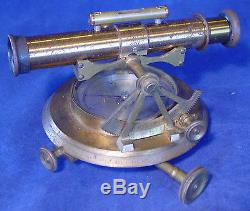
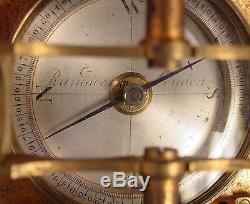
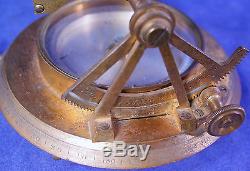


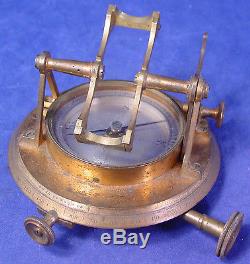

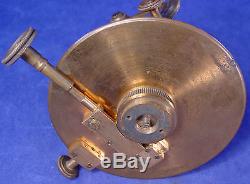

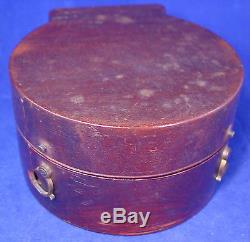
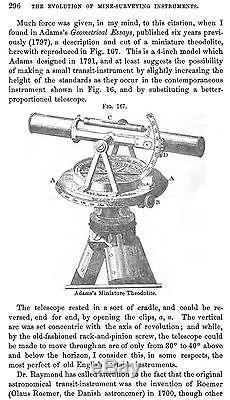

This is a nice Jesse Ramsden miniature theodolite, I cannot find any other examples of this instrument by any maker and can only find 1 reference to this style of theodolite (see last photo which calls this an Adam's Miniature Theodolite). Ramsden was the renowned maker of his day, he is credited with inventing the circular dividing engine. The scope of this theodolite measures 5 1/2 inches long, the compass needle is 2 inches, and the beveled edge plate measures about 4 inches diameter. The scope for this is not attached nor was it meant to be, it just rests in the cradles. There is a nice original wood case for the main compass (4 screws are missing that hold the hinges on), if the scope came in a case (my guess is a leather case) it has been lost to time. Optics and cross hairs are in good shape, the theodolite appears to be in great shape however I do not know what is missing on the bottom which is how it attached to a tripod? Here is some information on this famous maker Jesse Ramsden. (6 October 1735 5 November 1800) was an. He married Sarah Dollond, daughter of. After serving his apprenticeship with a cloth-worker in Halifax, he went in 1755 to. Where in 1758 he was apprenticed to a. About four years afterwards he started business on his own account and secured a great reputation with his products. Probably the finest 18th century instrument maker, his specialty was accurate scale division. Ramsden's major achievement was to invent a highly accurate "dividing engine" the apparatus used to divide the scale into degrees and fractions of degrees.
His design was considered so ingenious that the British Board of Longitude awarded Ramsden a prize of 615 pounds in 18th century terms, a small fortune. His "dividing engine" now resides in the Smithsonian Institution in Washington. Ramsden created one of the first high-quality. This led to his specialty in dividing circles, which began to supersede the quadrants in observatories towards the end of the 18th century. His most celebrated work was a 5-feet vertical circle, which was finished in 1789 and was used by.
In constructing his catalogue of stars. He was the first to carry out in practice a method of reading off angles first suggested in 1768 by the Duke of. By measuring the distance of the index from the nearest division line by means of a micrometer screw which moves one or two fine threads placed in the focus of a microscope.
Ramsden's transit instruments were the first which were illuminated through the hollow axis; the idea was suggested to him by Prof. He published a Description of an Engine for dividing Mathematical Instruments in 1777. Ramsden is also responsible for the. Named after him, and also worked on new designs of.
He was elected to the. Of an eyepiece was once called the Ramsden disc in his honour.
In 1791 he completed the. An equatorial mounted refractor telescope. Ramsden made a sextant much prized by Captain Cook in his voyages of discovery in the Great Southern Oceans.
He later made another sextant which was used by Captain Philip on the first fleet voyage from England to Botany Bay in 1788. Furthermore, the famous (to Australians) New South Wales (NSW) explorer Lieutenant John Oxley as Surveyor General of the (colonial) Territory (of NSW) relied upon a Ramsden made theodolite for his surveying in his journeys of exploration of the NSW interior during 181718. Some J E Ramsden instruments were signed Ramsden but not made by Ramsden. It was made by Matthew Berge around 1800 or 1801.
Ramsden died in 1800 and Berge, who was working underneath Ramsden, continued to make Ramsden's instruments. The engraving has the S that looks like a F was Berge signing for Berge. He did this for a very short time then signing as "Berge London Late Ramsden" On his design he put M Berge London. This continued until his death in 1819.
Berge was no Ramsden, but he had the same eye for quality as Ramsden. In the year 1782, it was proposed by British cartographers that the relative locations of both the Royal Observatory in Greenwich England and the Observatory in Paris France, be tied together by means of triangulation, and then the whole of Britain be divided into great triangles. Jesse Ramsden was appointed to build a theodolite that was capable of the accuracy required for such surveys. And so, in approximately 1782 Jesse Ramsden commenced construction on his Great Theodolite.The instrument when completed, (a three year project), incorporated a 3 foot diameter horizontal circle and weighed approximately 200 pounds. It was used by General Roy for locating the Greenwich and Paris observatories as well as the Ordinance Survey of Great Britain. For his part with Roy in this work he received the. The Great Theodolite continued being used for important surveys and is now housed in the Greenwich Museum in England. He died five years later at.
The item "Jesse Ramsden Miniature Surveying Theodolite 18th Century, Only 1 Known" is in sale since Monday, December 10, 2018. This item is in the category "Collectibles\Science & Medicine (1930-Now)\Engineering\Surveying Equipment". The seller is "klony" and is located in Kalispell, Montana.This item can be shipped worldwide.

